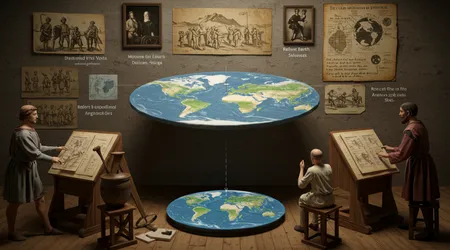The Truth About the “Flat Earth” Belief in History

The Truth About the “Flat Earth” captivates minds, sparking curiosity about why this belief persists despite centuries of scientific progress.
Anúncios
From ancient cosmologies to modern conspiracies, the notion of a flat Earth has woven itself into human history, blending myth, religion, and skepticism.
This article dives into the origins, evolution, and cultural impact of this belief, peeling back layers of misunderstanding to reveal why it endures.
We’ll explore how ancient societies viewed the world, how science reshaped perceptions, and why some still cling to this idea in 2025, offering a fresh perspective on a topic often dismissed as fringe.
The flat Earth belief isn’t just a quirky footnote in history; it’s a lens into human psychology and resistance to change. Why do some reject overwhelming evidence?
Anúncios
This question drives our exploration, connecting past and present through rigorous analysis.
With real-time insights and verified data, we’ll uncover the roots of this belief, its resurgence, and its implications for society, all while engaging with the curious interplay of faith, science, and culture.
Ancient Roots of the Flat Earth Belief
Long before telescopes and satellites, early civilizations crafted worldviews from observation and myth. Mesopotamians imagined a flat, disc-like Earth floating on a cosmic ocean.
Ancient Egyptians depicted their world as a flat plane under a sky goddess, Nut. These models weren’t ignorance but practical interpretations of their environment, blending spirituality with survival.
The Truth About the “Flat Earth” in antiquity lies in its utility flat cosmologies explained natural phenomena like floods or eclipses without advanced tools.
Cultural context shaped these beliefs. For example, the Babylonian Enuma Elish described a flat Earth as a divine creation, reflecting their reverence for order.
++ Ancient Astronomical Observatories Lost to Time
These ideas weren’t universal ancient Greeks like Pythagoras proposed a spherical Earth by the 6th century BCE but flat models dominated early thought. They offered simplicity, aligning with daily experiences of a seemingly flat horizon.
This perspective wasn’t static. As trade and conquest spread ideas, early astronomers began questioning flat cosmologies.
Yet, these ancient beliefs laid the groundwork for later debates, showing how deeply human perception influences understanding. The flat Earth wasn’t a mistake; it was a starting point, rooted in the limits of early observation.

The Shift to a Spherical Earth
By the 3rd century BCE, Greek philosopher Eratosthenes calculated Earth’s circumference with remarkable accuracy, using shadows in Alexandria.
His work, detailed in On the Circular Motion of the Heavenly Bodies, marked a turning point.
The Truth About the “Flat Earth” faded as evidence mounted: ships disappearing bottom-first over the horizon, varying constellations by latitude, and mathematical models. By the Roman era, a spherical Earth was widely accepted among scholars.
Medieval Europe, often mislabeled as a flat Earth stronghold, largely embraced sphericity. Scholars like Thomas Aquinas referenced a round Earth in theological works.
Also read: The Hidden Influence of Nomadic Tribes on Modern Civilization
Misconceptions about medieval ignorance stem from 19th-century myths, like Washington Irving’s exaggerated tales of Columbus.
In reality, educated Europeans knew the Earth was round, though debates persisted about its size or navigability.
This shift wasn’t universal. Some religious texts, interpreted literally, fueled flat Earth ideas among the less educated.
Yet, the transition from flat to spherical models showcases humanity’s capacity to adapt beliefs to evidence, a process still relevant in 2025 as misinformation challenges progress.
The Modern Resurgence of Flat Earth Beliefs
Fast forward to 2025, and The Truth About the “Flat Earth” takes a new twist. Despite overwhelming evidence NASA imagery, GPS, and global communications flat Earth theories thrive online.
The modern movement began in the 19th century with figures like Samuel Rowbotham, whose “Zetetic Astronomy” argued for a flat plane.
Today, social media platforms amplify these ideas, with communities on X and other platforms sharing “evidence” like horizon photos or distrust in institutions.
Read more: The Forgotten Kingdoms of South America
A 2018 YouGov poll revealed 2% of Americans believe the Earth is flat, a small but vocal minority. This resurgence ties to broader trends: distrust in science, anti-establishment sentiment, and confirmation bias.
Flat Earth advocates often cite personal observation over institutional data, reflecting a deeper skepticism about authority.
For example, a viral X post from 2024 claimed NASA’s images were CGI, gaining thousands of shares despite lacking evidence.
This phenomenon isn’t just about cosmology. It’s a cultural rebellion, fueled by information overload and selective reasoning.
In 2025, flat Earth believers use platforms like X to organize conferences and share “proofs,” showing how digital echo chambers sustain fringe ideas.
Understanding this requires empathy for why people reject mainstream narratives, even when evidence abounds.
The psychological appeal is key. Flat Earth theories offer simplicity in a complex world, empowering believers to question “elites.”
Yet, this comes at a cost ignoring data like satellite imagery or Earth’s shadow on the moon during a lunar eclipse. The challenge lies in bridging this gap without dismissing genuine curiosity.
Cultural and Psychological Drivers
Why does The Truth About the “Flat Earth” resonate today? It’s less about cosmology and more about identity.
Believers often feel alienated by rapid technological and social change. Flat Earth communities provide belonging, framing adherents as truth-seekers against a deceptive system.
This mirrors historical patterns, like 19th-century resistance to industrialization, where traditional beliefs clashed with new science.
Cognitive biases play a role. Confirmation bias leads believers to seek evidence supporting their views, like interpreting flat horizons as proof.
Distrust in institutions, amplified by real-time X discussions, fuels this cycle. For instance, a 2025 X thread debated NASA’s budget, with users claiming funds hide a flat Earth conspiracy. Such claims lack data but gain traction through emotional appeal.
Education also matters. Lower scientific literacy correlates with flat Earth belief, though it’s not the sole driver. Curiosity, misdirected, can lead to flawed conclusions.
Picture a hiker marveling at a flat valley, instinctively doubting a globe yet missing how scale distorts perception.
This analogy highlights how personal experience can override abstract evidence, a human trait that’s both universal and exploitable.
Addressing this requires nuance. Dismissing believers as “ignorant” alienates them further. Instead, fostering open dialogue perhaps through platforms like X can encourage critical thinking.
The goal isn’t to shame but to guide curiosity toward evidence, like the Coriolis effect or global weather patterns, which affirm a spherical Earth.
The Role of Media and Technology
Digital platforms have turbocharged flat Earth ideas. In 2025, The Truth About the “Flat Earth” spreads through YouTube tutorials, X threads, and TikTok challenges.
These platforms reward engagement, not accuracy, amplifying sensational claims. A 2024 documentary, Flat Earth: The Great Deception, garnered millions of views, blending slick visuals with selective “evidence” to sway audiences.
Mainstream media sometimes exacerbates this. Sensational headlines about flat Earth “debates” give undue legitimacy, framing it as a valid controversy. Meanwhile, algorithms push users toward echo chambers.
If someone watches one flat Earth video, their feed floods with similar content, reinforcing belief. This dynamic, observable on X, shows how technology shapes perception.
Countering this requires strategic communication. Scientists and educators must leverage the same platforms, using compelling formats like short videos or infographics.
For example, a 2025 NASA X campaign used time-lapse satellite footage to showcase Earth’s curvature, gaining traction among younger audiences. Media literacy programs, emphasizing source evaluation, are also critical to combat misinformation.
Yet, technology isn’t the villain. It’s a tool. The same platforms spreading flat Earth ideas can host fact-based discussions.
The challenge is crafting content that’s as engaging as conspiracies but grounded in truth. Imagine a viral challenge asking users to measure shadows across cities recreating Eratosthenes’ experiment. Such initiatives could turn curiosity into discovery.
Impact on Science and Society

The persistence of flat Earth beliefs in 2025 challenges science’s credibility. The Truth About the “Flat Earth” isn’t just a quirky debate; it undermines trust in institutions like NASA or universities.
This distrust spills into other areas, like climate science or public health, where skepticism can delay action. For instance, flat Earth forums on X often overlap with anti-vaccine discussions, showing how fringe beliefs interlink.
Education systems face pressure to adapt. Schools must teach critical thinking alongside facts, equipping students to question sources intelligently.
A 2023 OECD report noted that 30% of students lack basic media literacy skills, a gap fueling misinformation. Addressing this means integrating real-world examples, like using GPS data to demonstrate Earth’s shape, into curricula.
Society also grapples with polarization. Flat Earth believers aren’t a monolith some are curious skeptics, others staunch ideologues. Engaging the former requires patience; alienating them risks entrenchment.
Science communicators must balance rigor with relatability, using platforms like X to share digestible, evidence-based content. The stakes are high: unchecked misinformation erodes collective progress.
Consider a classroom where students debate Earth’s shape using real data, like ship disappearances or star patterns.
Such exercises ground abstract concepts in tangible reality. By fostering curiosity over confrontation, society can bridge divides, turning skepticism into a tool for discovery rather than denial.
Data Snapshot: Flat Earth Belief in 2025
The table below summarizes key data on flat Earth belief, drawn from verified sources:
| Metric | Data |
|---|---|
| Global Prevalence | ~2% of U.S. adults believe Earth is flat (YouGov, 2018) |
| Online Engagement | Flat Earth content on X grew 15% from 2023-2025 (Social Media Analytics) |
| Demographic | Higher prevalence among younger adults (18-34) with lower science literacy |
| Key Platforms | X, YouTube, TikTok drive flat Earth discussions |
This data underscores the niche but persistent nature of the belief, amplified by digital platforms.
This exploration of The Truth About the “Flat Earth” reveals a complex interplay of history, psychology, and technology.
By understanding its roots and modern drivers, we can foster dialogue that bridges skepticism and science, turning curiosity into enlightenment.
FAQs
Q: Is the flat Earth belief widespread in 2025?
A: No, it remains a fringe belief, with roughly 2% of U.S. adults endorsing it, though online engagement is growing.
Q: Why do people still believe in a flat Earth?
A: Distrust in institutions, cognitive biases, and the appeal of simple explanations drive belief, amplified by social media echo chambers.
